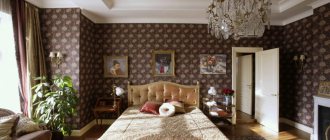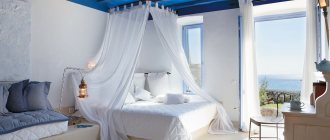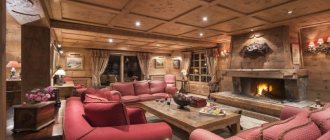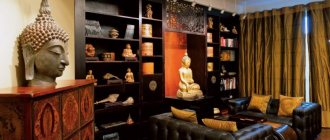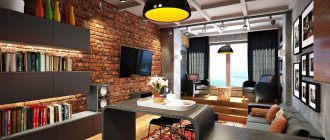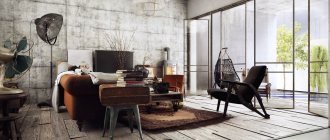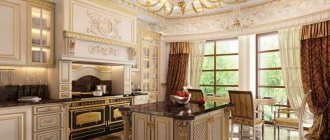European style trends are presented in a wide variety. Italian style occupies a special place among them. It was he who managed to absorb all the luxury, practicality, and warmth of the European Mediterranean. In Italy, functionality and home comfort are valued. Modern Italian style in the interior adheres to these canons in every detail: from finishing to decor. It suits active, freedom-loving people. This publication discusses the main features of the classic, modern Italian style in the design of residential premises.
Italian style combines classic design and architecture with the simplicity of a provincial village
Distinctive features of Italian style in the interior
Italian interior differs from others in several attributes:
- careless eclecticism combines pompous luxury with rustic simplicity, and each designer is free to determine for himself which direction he likes best;
- natural materials in the decoration create a pleasant, natural atmosphere of warmth;
- The style is characterized by large windows that let in maximum light and light tulle curtains that do not prevent it from flowing in;
- the abundance of fresh flowers creates the feeling of a summer garden;
- a room (even a large one) is usually combined into one and zoned using arches and furniture - in an apartment you can include a balcony in the room by making an arch in the wall that separates it;
- curtains made of bright beads or light fabrics are hung in the arches, and sometimes they are left completely open.
The main colors of the Italian style are warm shades of beige, delicate blue, dark green and purple, and natural wood. Bright accents are not welcome.
The main distinguishing characteristic is the maximalism of the solutions and the general feeling of a sunny afternoon somewhere in the Mediterranean, even on a stormy February evening.
Finishing
Intending to bring to life ideas regarding the interior in the format of Italian classics, special attention should be paid to the correct design of the walls, floor and ceiling space, which should interpret the exquisite apartment as realistically as possible.
Here you can use Venetian decoration or wallpaper with vertical stripes, mosaic tiles or artistic painting that imitates frescoes. Regarding the floor, the priority will be noble wood or natural stone, an alternative to which will be parquet mosaic without final processing. As for the ceiling, the obligatory solution will be stucco with a chandelier located in the center, while shades of ivory will add a touch of modernity.
Varieties of style and color palette
Colors vary depending on the style: they can be warmer, cooler, brighter, or duller. Everything is determined by which variation is used.
Italian rustic style
Natural materials, a lot of wood and stone, no wallpaper and, of course, no plastic. There is a lot of light, but the colors are muted: bright accents in the rustic variety are especially inappropriate. Homemade decorative elements are a must: an embroidered napkin under a vase, carvings, wooden figurines, a hand-knitted rug on the floor.
If you are decorating a kitchen, then you need clay dishes that look as if the owners themselves sculpted them.
Italian Mediterranean style
Mediterranean style should be reminiscent of warmth, summer and the sea. High ceilings, a lot of light, the decoration is not wood, but stone and plaster. Warm colors that are uncharacteristic of the style are a must: yellow, soft green with a yellow bias. Be sure to have arched openings covered with jingling beads, frescoes and mosaic decoration, which looks especially good in the bathroom (the bathtub itself should be the size of a small swimming pool).
Italian classic style
All the same arches and high ceilings, but the colors are often light, without bright accents, and ostentatious luxury is also added: stucco molding, mirrors in heavy frames, classical paintings, bulky furniture, metal chandeliers with crystal elements. Preferably sculptures, figurines and porcelain to complete the picture.
The main thing is not to overload and not make the classic Italian style too bulky, and the room too crowded and cramped.
Italian Tuscan style
Tuscany is a province in Italy, and Tuscan style blends French, Italian and Spanish influences. The colors remain natural, but become more vibrant. Plaster is placed on the walls, tiles or marble are placed on the floor.
The furniture is lush, not too bulky, with metal elements. Be sure to have fresh flowers and a landscape with a vineyard on the wall.
Modern Italian style
The design of an apartment in a modern Italian style allows you to replace traditional materials with more modern ones. You can put laminate on the floor, not parquet. Place wallpaper on the walls rather than covering them with tiles or plaster. Ceilings can be made suspended (especially if a fabric version is used).
And of course - a lot of light, a lot of space (almost like in a loft), a lot of natural colors, and always trinkets that refer to Italy in different historical periods.
Italian is not so simple: types of style
In general, the concept of style is the same, but designers and homeowners express it differently.
Rustic
The differences are freshness and naturalness. In finishing, the leading positions are occupied by solid wood, large boards, abrasions on surfaces (doors, windows), and iron fittings. Solid wood is also used in the manufacture of furniture. In this variety there is a place for natural textiles, but there is no place for bright accents and colors; marble and homemade decor are welcome.
Mediterranean
This variety is characterized by the presence of arched openings, frescoes, and a combination of soft yellow and ocher. Mediterranean spaces have wrought-iron lamps, soft, pleasant lighting is thought out, and wicker decor is harmoniously integrated. Fresh flowers and decor in the form of carved frames and figurines are placed in such rooms.
Classic
Classic Italian is a variety with ostentatious luxury. Solid wood furniture decorated with carvings, stucco molding, frescoes, semi-columns and arches prevail here. To decorate classic Italian rooms, watches, paintings, and handmade accessories are used. Also, the difference between the classics is the maximum open space. This means that such rooms have huge windows, access to a terrace or balcony, as well as combined areas without partitions or doors.
Tuscan
This variety is from the province of the same name and organically combines Spanish, French, and Italian styles. The main sources of inspiration are nature, warmth, vineyards, cypress trees, architecture. Aged plaster is used to decorate the walls; it is possible to use frescoes and moldings. Beams in this style are not specially hidden, and the use of granite, marble, and tiles is encouraged in floor finishing. Decorative elements and techniques include vases, lace, dishes and painted furniture.
Modern
In some ways it is similar to the classic variety, but in this case decorative plaster, wallpaper, and decorative stone are used as finishing materials. Instead of solid wood, it is permissible to use MDF, and instead of marble - acrylic. The furniture is even without carved elements and is quite modern: from the coffee table to the sofa.
Room layout
Italian style in the interior of an apartment can be divided into two directions: classic and modern. Classics are most often called traditional Italian styles, without dividing them into Tuscan, rustic, Mediterranean and directly classic. They look great in cottages with high windows and spacious rooms. Columns and arched openings will be an integral part of the interior.
High ceilings are decorated with beams, and the obligatory asymmetry of the room is created with the help of colonnades and niches. Don't forget to prepare a place for a full fireplace.
A modern Italian-style apartment can be quite modest in size; the main emphasis is on decor and interior content. However, if you have a balcony or windows with French glazing to the floor, they can be used for maximum immersion in this direction.
A modern Italian interior will be a real find for owners of premises with complex geometry.
Everything that seemed to you as a disadvantage of the layout: the absence of a full-fledged corridor, an asymmetrical niche in the wall, a doorway that you want to move a few tens of centimeters - Italian design will turn these disadvantages into advantages.
a guest room
The living room in this style is characterized by the most fashionable things and pieces of furniture of antique art. So, among all the furniture you can often see classics made of natural wood with forged elements.
Most often this is a simple sofa upholstered in genuine leather. To somehow decorate the sofa and make it less strict, use eye-catching pillows as decor.
A place to relax is often complemented by a small cute coffee table and a pair of armchairs. A wine bar and chest of drawers would look appropriate in the living room interior.
The walls in the living room are “dressed” in olive color, in terracotta.
In addition to natural lighting, it is worth considering additional lighting in the living room - lighting that illuminates the decor.
Marble and ceramic figurines make the style more sophisticated, and bronze candlesticks completely transform the room.
Italian style in the interior: past and present
The modern version of the Italian style has its predecessor. It is to him that the design we are familiar with owes many of the basic characteristics that are so loved by a wide range of the public.
The basis for the Italian style was the design, which is called Tuscan. Its name was given by the province of Tuscany in the central part of Italy, and it arose thanks to objective historical and economic historical processes.
In the first half of the last century, Italy demonstrated an avalanche-like growth of cities and urban population. The villagers went to work, their habitats became empty. In the cities there was not enough housing or places to build it, and then the townspeople gradually began to populate the nearest suburbs, abandoned by their previous inhabitants.
This became possible with the development of railway and road communications.
City dwellers, recent villagers themselves, inhabited abandoned buildings, arranging them to their liking. Houses in Tuscany were traditionally built from stones and clay, often with patios and open terraces with arches supported by columns.
Most often, such buildings did not differ in ceiling height, but were spacious. The new residents provided the houses with strong shutters and oak doors so that other settlers would not want to redistribute the property. For the most part, the windows were low and relatively small, often raised higher to the ceiling.
This is how the famous Tuscan architecture developed, which is a cross between a fortified monastery and a typical Mediterranean house with the obligatory courtyard, arches and columns.
The distinctive features of the style were archaic simplicity and practicality, the use of natural materials, among which stone, clay and ceramics came first.
The natural Italian liveliness of mind and thirst for beauty helped to decorate such an interior with examples of painting in the spirit of the old masters, sculptural examples, and traditional Italian frescoes on wet or dry plaster.
The Tuscan style was distinguished by laconicism and even severity. Naturally, over the years it changed, softened, and became embellished. There are much more wooden objects and furniture in it, because the Italians are famous masters of furniture production.
The decoration was complemented by a variety of ceramic tiles, which became brighter and richer. Mosaics also appeared, including glass ones. It was complemented by stained glass, colored glass and glass products.
Modern Italian style has retained many basic features. In particular, architectural brevity and simplicity, in which the symmetry of ancient designs is clearly visible. The most popular architectural form for the Italian style is the arch.
Windows, doors, interior partitions, niches in the room, and simply decorative elements designed to decorate the space can be made in this form.
Simplicity and practicality are continued in the finishing method. For walls, textured plaster or paint is often chosen, which is easy to apply, looks good and can be quickly updated if necessary. You can choose a rustic, even rough surface, or make the wall perfectly smooth. Plaster and paint are preferably matte, absorbing light.
Ceramic tiles are actively involved in the Italian style.
It can lie on the floor in the form of ancient stone slabs, decorate the lower third of the wall, or rise in columns in the corners of the room. Unlike our traditions, Italians also use tiles in residential areas, without limiting their distribution to the kitchen and bathroom.
Often, tiles are chosen with an intricate oriental pattern, similar to Arabic script. The influence of the Moorish style is felt here, but you can’t erase the words from the song, especially since the styles of the Mediterranean basin are related and often demonstrate similar borrowings.
In the Tuscan style, the influence of antiquity was not too noticeable; rather, peasant thoroughness and practicality played the first fiddle. However, subsequently, in the second half of the 20th century, elements reminiscent of the glorious past of the Apennines began to be more actively introduced into the Italian style.
In the modern version of the Italian style, you can see many features that refer us to ancient examples.
This includes the symmetry of the design of the space, and additional decoration of columns in the form of antique porticoes and pilasters, and stucco decorations, and sculptural elements. The interior layout itself began to gravitate toward antiquity, with clear centering. Although for a Tuscan interior, the presence of a clearly defined center was precisely an optional feature.
Lovers of Italian design can choose the mood they want to bring into the interior.
By choosing a more practical, solid and rough style, gravitating towards the original Tuscan interior, you can get a cozy, albeit somewhat brutal, image. It will promote environmental cleanliness and remove everything superficial and excessive from the environment, and will also give a feeling of comfort and security to every inhabitant of the house.
By adding more sophistication in the form of intricate patterns, whimsical furniture made of natural wood - of course, Italian production - a few antique paintings in old frames, you can get a solid and respectable style with a clear hint of aristocracy.
Modern trends of minimalism and constructivism can also be superimposed on traditional Italian basic principles.
The result will be a restrained, but nevertheless expressive interior with an emphasis on natural materials and functional furniture, with original arched design of open doorways and ceramic decors.
Subtleties of selection of finishing materials
In an Italian interior, the quality of the room’s finishing plays an important role. When choosing finishing materials, the following criteria must be taken into account:
- Environmentally friendly. Residents of sunny Italy value nature and are wary of anything that could be harmful to health. Enormous harm can come even from the paint used to decorate the walls in the room. All building materials purchased for the home must be environmentally friendly.
- Naturalness. When choosing such an interior solution, you need to be prepared for high costs. This interior solution is characterized by a natural finish. Wood, expensive marble, high-quality plaster, and natural stone are used.
- Purpose of the room. The choice of finish should be based on the characteristics of a particular room. The bathroom has high humidity. It can only be covered with water-resistant materials. In a nursery, a comfortable climate plays a huge role. The baby should not run on the cold floor. The floor finish should be selected based on this requirement.
- Performance. Finishing materials must be strong, resistant to mechanical damage and household cleaning products. High performance properties will allow you to enjoy a consistently beautiful environment in your apartment for many years in a row.
- Fire safety. Many natural facing materials are flammable. For example, an abundance of wood trim can lead to tragic consequences. All wood must be treated with a special impregnation. A more serious approach to the installation of the electrical network will help protect your home from fire. This issue should only be dealt with by a professional.
- Compatibility with each other. The cladding of the floor, walls, and ceiling should be in harmony.
What is this style?
Initially, when it comes to Italy, ideas about southern beauty are born in the head at the subconscious level. For this reason, designers pay special attention to it when they propose Italian-style house designs; tradition is present in literally everything here. At the same time, Italian houses have not only external differences, but also their own “Italian internal filling”.
The style can be seen in literally everything, including the general interior of the living space, finishing materials, color schemes, accessories, etc.
All of the above is reminiscent of the Mediterranean, incorporating not only luxury, but also the tranquility, comfort and simplicity of the peninsula.
Curtains are an integral part of the decor
It is difficult to imagine authentic Italian style in the interior without luxurious Italian curtains. Their first appearance dates back to the eighteenth century. Such curtains were previously used in the designs of castles and palaces. They were the embodiment of aristocracy and sophistication. Today, you also cannot do without them when decorating the design of an apartment, cottage, or dacha.
Real curtains from Italy have several distinctive features:
- The curtain rods secure the top of the curtains firmly. The curtains are opened by gathering them diagonally, followed by fixing them with a cord. The material can be dissolved and collected as desired.
- Curtains for wide windows are not made in one piece. They do not connect in the middle; they only cover the corners of the window opening. This option is perfect for the living room.
- Many curtain models are multi-layered. The canvases simply overlap each other. To preserve the design, translucent fabric is used to make canvases.
- Curtains for the kitchen are usually rolled. They are convenient to use, easy to clean, and transmit the required amount of sunlight. Roller blinds can be decorated with beautiful patterns and ornaments.
- Curtains made in Italy are expensive. Don't look for a cheap alternative. This product is a fake. It will quickly lose its appearance.
Italian interior decor: from lighting to textiles
Attention to detail - as in any interior. Some styles have more details, some have less. Let's consider the main elements of Italian style decor and their concentration in the room.
Textile
. Fabrics in the interior of windows of this style should be light. Additional decor, garters in curtains and curtains are not welcome - this will only complicate the overall perception of the room. Curtains are attached to simple versions of cornices: tubular or forged. Materials are cotton or linen, but other options are also possible, for example, light curtains made of organza, tulle, taffeta. The color scheme is one tone in natural shades of muted green, yellow, white, beige.
Lighting
. Unobtrusiveness and softness, absent-mindedness - recommendations for choosing and organizing lighting. In a room, you can focus on one light source and the diffused glow from it. Another option is to install local sconces that will illuminate the room around the perimeter and create shading in the center of the space. The last technique is good because it creates the effect of a natural glow: as if sunlight is breaking through from the windows. Options for light sources - chandelier made of cast iron, crystal or forged, sconces, spherical shades, kerosene lamp.
Accessories for decoration
. These could be ceramic dishes, framed paintings, potted plants for the kitchen, a fruit bowl, a carpet, reproductions for the living room, candlesticks, frescoes, mosaics for the bedroom.
Window
. We have already decided that large windows are one of the characteristic features of the Italian style in the interior and are relevant in any of its varieties. The design of windows in the classics allows the use of jacquard, velvet, in a modern style - unpretentious plant motifs as a pattern.
To decide on the direction of the renovation and structure your wishes, find several photos of Italian-style interiors - this way you will understand which materials, elements, and accessories are closest to you.
Apartment interior in different rooms
In addition to the characteristics of the style varieties, the purpose of the room also influences the decor. The hall, corridor, kitchen and bedroom require a different approach to design.
Kitchen
This is exactly the room where the decor looks especially good. Tile or natural stone is laid on the floor. The walls are covered partly with mosaic tiles (usually in the kitchen apron area) and partly with plaster. The ceiling is whitewashed, optionally leaving beams on it. An Italian-style kitchen is usually bright: the lighting should be plentiful, the chairs around the table should match the style, the curtains should be light and allow light to pass through well.
Accessories include a vase of flowers on the table, intricate sconces in the work area, earthenware or porcelain dishes, a painting on the wall.
Living room
There is also room to spread out in the living room. It can be finished with stone, but usually wood is preferred. Parquet is placed on the floor, beautiful wallpaper or plaster is placed on the walls. There is a lot of light in the room, paintings, milky, delicate shades in the design. Be sure to have a small sofa, comfortable armchairs, a floor lamp, and if the budget allows, then a fireplace and antique decoration.
Even in the rustic variety, a little luxury is permissible, while classic presupposes its obligatory presence.
The overall impression is beautiful, cozy, pleasant to live and no less pleasant to visit here.
Bedroom
Dark, deep colors are in demand in the bedroom - blue, dark green, olive. They calm you down and put you in a sleepy mood. Be sure to have a large bed, a pile of pillows in the bed, a closet - a large built-in one (in the modern version), with carvings on the doors (in the classic version) or roughly put together, with a simple design (in the country version).
It is better to cover the doorway not with a classic light curtain, but with a heavy curtain that will muffle the sounds of the rest of the house.
Children's
In the nursery, you can decorate the room a little more freely than in other rooms. Colored mosaics, paintings, and drawings on the walls are acceptable here. Of course, calm shades should predominate, but the nursery allows you to include bright accents. In the end, the room should not look strict, but, on the contrary, fun and interesting.
Bathroom
The room is predominantly tiled. It is appropriate to style it like a Neapolitan bathroom, with frescoes on the walls, small mosaics on the floor, with an abundance of small lamps and cute accessories.
Everything should fit into the color scheme and create a feeling of purity and light. Even a soap dish should look stylish and fit into the interior design concept.
When the renovation is completed, taking photos in such a bathroom will be a pleasure.
Hallway
The hallway also fits into the overall project: abundant light (preferably natural, but if there is no window, then an overhead one is also possible), a simple layout, a furniture trio - a wardrobe for outerwear, a shoe stand and a small chair for putting on shoes.
A mirror is a must, the frame of which must match the style variation.
Living rooms
Living room
In this case, the walls are in the foreground, or rather their decor, close to the Country style. The best option is wallpaper with a large pattern or stucco. Also, an Italian-style living room includes paintings with landscapes characteristic of Italy. In one of the corners of the room you can place a large plant in a clay pot. But it is not advisable to decorate the hall with too large decor.
In addition, the modern Italian style is the use of furniture as large accessories: a couch, sofas, a low cabinet, etc. Given such a number of massive objects, an Italian-style living room should not be overloaded with small accessories. It will be enough to decorate the room, for example, with Italian-themed artificial flowers or a low dark glass vase on the coffee table. Carved doors in warm colors will also look good in this case.
Spacious living room in Italian style
Living room in modern Italian style
Bedroom
An Italian-style bedroom consists of plain light blankets or bright decor of bedspreads hanging from the edge of the sofa or bed, light-colored walls and a large number of decorative pillows of various colors and sizes. You should choose pillows that repeat the color gradation of the door, ceiling, bed, walls, or, on the contrary, sharply contrast with them. Beds most often occupy the center of the room.
You can complete the interior in Italian style by decorating the bedroom windows with organza curtains (suitable for all styles: Loft, Provence, etc.). Italian-style curtains, like other textiles, are often used to highlight wall decorations such as paintings or mirrors, and are sometimes used to frame beds.
Italian style bedroom in white and beige tones
Bedroom in bright Italian style
Kitchen
But an Italian-style kitchen is the most simple decor: a massive table in the center of the room, open sideboards with dishes, patterned curtains on the windows, simple wallpaper and doors, wooden chairs, soft sofas and small accessories. It is also worth knowing that an Italian-style kitchen should not be made in too bright colors (like the living room): discreet walls, ceiling and floor. Italian style kitchen design is minimalism!
Italian style wooden kitchen
Rustic Italian style kitchen
Kitchen in modern Italian style
Hallway
It’s quite simple to create an Italian style in the hallway: any hallway will be decorated with a fabric composition or a large painting opposite the front door, a candlestick or a bright napkin on a table for keys, patterned wallpaper and a wooden wall hanger.
Living room and hallway in Italian style
Bathroom
Just like the hallway, the bathroom requires saving space. The main large elements should be placed on the walls so that they do not take up much space. But, in this case, the Italian style allows for a little more small objects than, for example, in the hallway.
In addition, the bathroom uses upholstered furniture in the Country or Provence style: poufs, small sofas, upholstered chairs, etc.
An Italian-style bathroom is a boudoir, that is, a room in an apartment intended not only for water treatments.
Balcony
If the house has a balcony, you can also create an interior in the Italian style: forged fences, flower pots, etc. But in this case it is not advisable to glass the balcony.
Note: a balcony in Italy is often used as a botanical garden, but in our conditions the climate is not entirely suitable for this.
Lighting
On the one hand, residents of southern countries are accustomed to bright natural light, on the other hand, this is why they are not drawn to lighting their homes too brightly, especially since there are no very long nights here. That is why the main chandelier, no matter how lush and huge it may seem, in an Italian-style room never gives off too much light, but shines softly and diffusely.
Of course, for certain needs, good lighting is still necessary, but this issue is solved by lamps that provide spot light.
Most often these are small wall sconces, leaving the center of the room in light twilight. According to the logic described above, the modern branch of the Italian style is very drawn to various stretch and suspended ceilings - they allow you to build in spotlights and not take up space near the wall.
Furniture
For aesthetically-oriented Italians, harsh chopped Nordic forms of furniture are something completely unacceptable. Southerners, on the contrary, love sophistication and smoothness in everything, which is why most furnishings contain light waves, curves and even patterns in their contours. If it is a table or a cabinet, then it should have small curved legs - it’s beautiful.
The inhabitants of Italy, by nature, are not accustomed to any harsh tests, so they look for comfort and convenience in everything. The predominant part of the furnishings fits the concept of upholstered furniture here - these are numerous sofas, armchairs and poufs.
Even the chairs at the dining table here should be soft and always have a high back - this is a matter of comfort.
Upholstered furniture upholstered in fabric, as well as bedroom sets, largely determine the color scheme of the room. We have already talked about what colors are welcome in Italian style, and textiles are selected according to the logic to be a bright accent against the background of the overall range.
Italians do not accept boring dullness, it puts pressure on them, and this rule is relevant not only in the nursery, but even in the usually strict (in our understanding) corridor.
Is there only one team working on site?
As a rule, one team replaces another - our company has a wide staff of highly specialized specialists, thanks to which each specialist performs work within the scope of his competence.
view album in new window
Accessories and decor
It is not for nothing that Italy is considered a country with a very developed art, but all the great creations of recognized masters of painting and sculpture initially stood in the houses of wealthy Venetians, Genoese, and Florentines. Even if simpler citizens could not afford a real masterpiece, do not forget that the masters had ten times as many students, who also left a lot of heritage - in a word, one cannot do without paintings and figurines.
In addition, the Italian city-states actively traded with the entire Mediterranean, and therefore their inhabitants could boast of beautiful imported porcelain.
